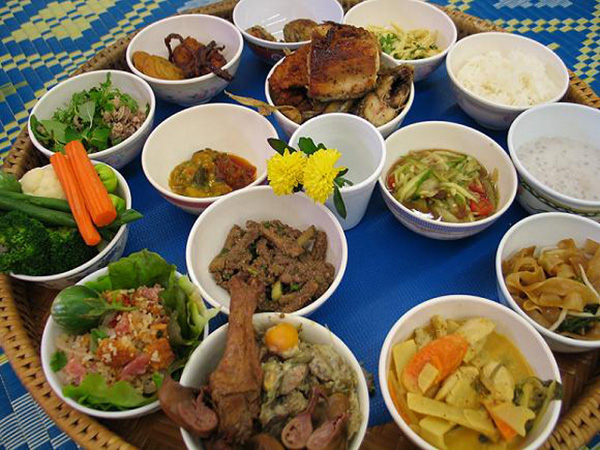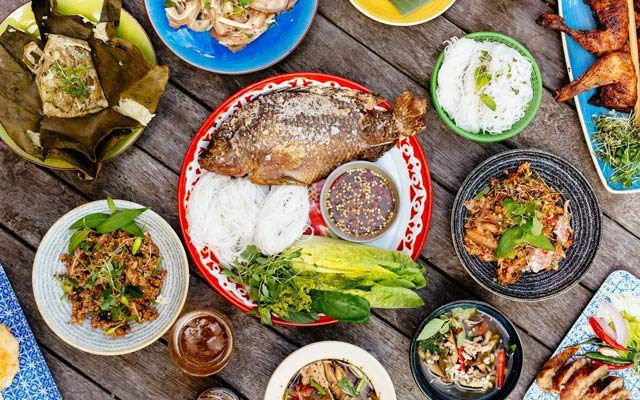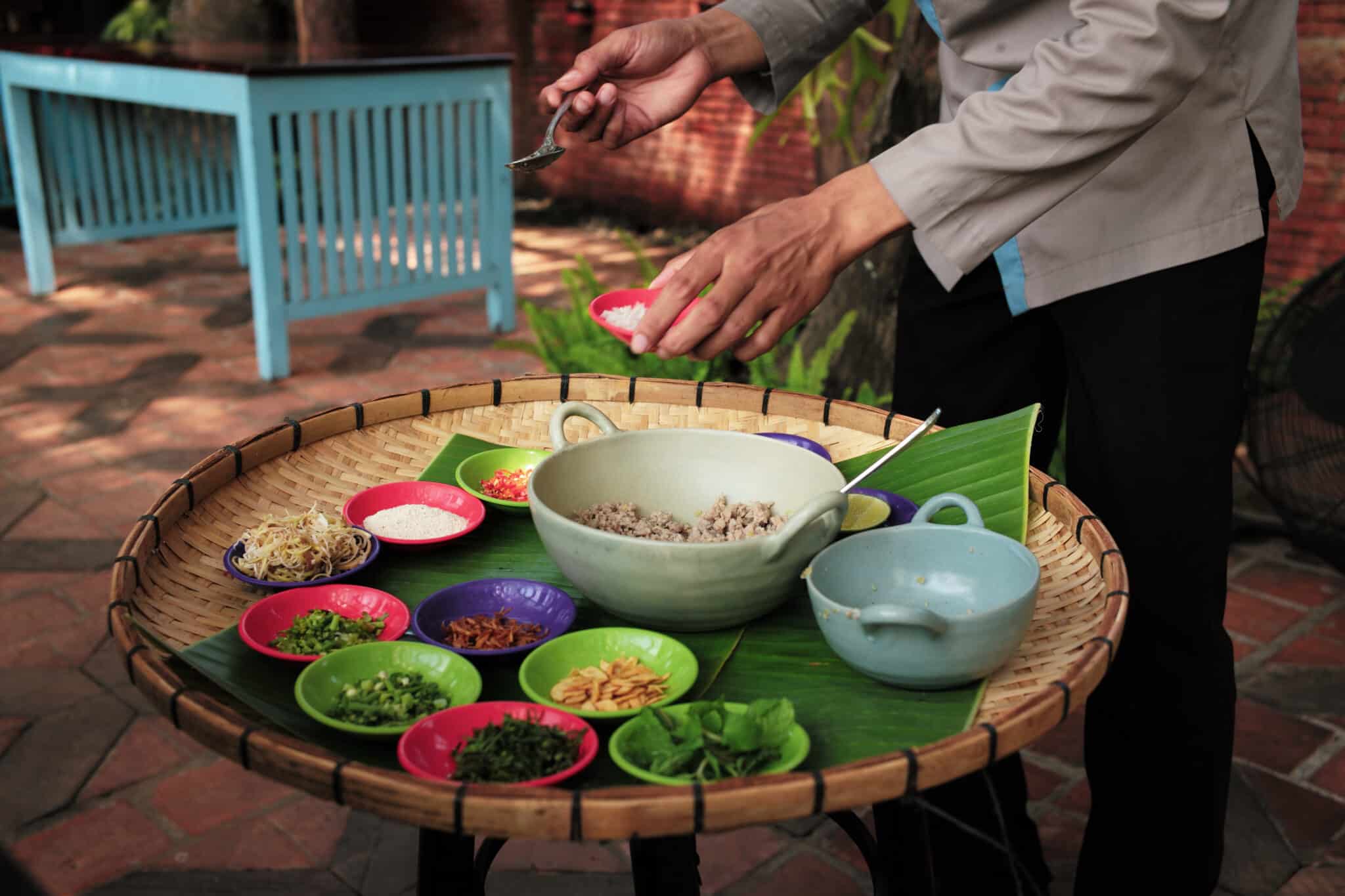Laos' Gastronomic Delights: A Journey Through Local Cuisine
Introduction to Laos' Gastronomic Delights
When it comes to unearthing hidden culinary gems, few places fulfil that promise, like Laos. Nestled in the heart of Southeast Asia, this country is often overshadowed by its neighbours, yet its food culture is rich with unique flavours and textures that tell a story all its own.
Overview of Lao Cuisine
Lao cuisine predominantly features fresh ingredients, vibrant flavours, and a wonderful balance of spices that reflect the lush landscape of the region. One element that stands out in Lao dishes is sticky rice, which serves not just as a staple food but as a central part of cultural identity.
Almost every meal revolves around this staple, making it a beloved and essential component of the Lao diet. A distinctive characteristic of Lao cuisine is its communal style of eating. Meals are often shared, with several dishes placed in the middle of the table, allowing diners to experience a variety of flavours in each sitting.
Imagine gathering around with friends or family, sharing bowls of fragrant dips, fresh herbs, and perfectly grilled meats—it's an experience that fosters connection and warmth.
Influences on Lao Food Culture
The culinary landscape of Laos has been shaped by various cultural influences throughout history, resulting in a diverse and exciting food scene. Some key influences include:
- Geographic Diversity: Laos is bordered by Vietnam, Thailand, Cambodia, China, and Myanmar, which means that many culinary elements are cross-pollinated. For instance, you might notice the use of coconut milk—a staple in Thai cooking—appearing in some Lao dishes.
- Ethnic Diversity: Laos is home to over 49 ethnic groups, each contributing their distinctive tastes and cooking techniques. From the spicy Ilak dishes of the Hmong people to the rich broth of Khmu soups, these varying ethnic traditions create a vibrant tapestry of flavours.
- Historical Trade Routes: The ancient trade routes also introduced spices and cooking methods from neighbouring regions, enriching the local food culture. For example, the use of herbs such as lemongrass and galangal in many Lao recipes traces back to Indian influences brought by traders.
- Local Ingredients: The reliance on fresh, local produce is a hallmark of Lao cuisine. Herbs, vegetables, and proteins are often sourced from local markets, ensuring exceptional freshness and flavour.
Lao cuisine is a delightful exploration of the senses. With every bite, you embark on a journey that speaks volumes about the land, its people, and the myriad influences that have shaped this unique culinary heritage. So, whether you're dining at a local street food stall or indulging in a home-cooked meal, the food of Laos offers an intimate glimpse into its vibrant culture.

Traditional Lao Dishes
As you delve deeper into Laos' culinary offerings, you will come across its traditional dishes that are not just meals but cultural experiences that evoke the warmth and hospitality of the people. These dishes are often the heart of gatherings and celebrations, bringing friends and family together to share food and stories.
Sticky Rice and Dips
First and foremost, let's talk about sticky rice. This staple is more than just a food item in Laos; it's an integral part of everyday life and a symbol of the nation's culture. Served in a woven bamboo basket, sticky rice is simply irresistible, and there's a delightful ritual associated with it. Here's what makes sticky rice a beloved favourite:
- Texture and Taste: Sticky rice is unique in that it clumps together, making it easy to pick up with your fingers. The chewy texture, combined with its subtle sweetness, complements a variety of dips perfectly.
- Versatility: While sticky rice is served with almost every meal, it pairs especially well with traditional dips. Dips such as jaew bong (a smoky chilli dip) or jaew maklen (a tangy blend of tomatoes and herbs) are often present at any Lao table.
- Dipping Ritual: The act of dipping sticky rice into these sauces is almost ceremonial. You take a small ball of rice, dip it into your chosen sauce, and enjoy the burst of flavours. This communal style of eating fosters conversation and connection, making meals memorable experiences.
Larb and Tam Mak Hoong
Next on our culinary journey through Laos is larb, a dish that is not just a meal but an embodiment of Lao identity. Larb, a type of meat salad, is usually made with minced meat—be it chicken, beef, or fish—mixed with fresh herbs, lime juice, and toasted rice powder. Here's why Larb garners so much affection:
- Fresh & Flavorful: The bright flavours resulting from lime juice, mint, and cilantro combined with the crunch from toasted rice create a dish that excites the palate. Each bite offers a complexity of textures and tastes, making it a delightful option for any meal.
- A Celebration Dish: Larb is often served during celebrations and ceremonies, symbolising prosperity and friendship. If you ever have the chance to attend a Lao wedding, you can bet that Lara will be centre stage on the banquet table.
Accompanying larb is tam mak hoong, a refreshing papaya salad that evokes the essence of Lao cuisine. Made from shredded green papaya, tomatoes, lime, fish sauce, and often a dash of chilli, this dish strikes a perfect balance of sweet, sour, and spicy.
- Ingredients: It's incredibly easy to make and requires minimal ingredients:
- Green papaya
- Cherry tomatoes
- Lime juice
- Fish sauce
- Chilli peppers (optional for heat)
- Snack or Meal: Tam mak hoong can be enjoyed as a side dish or a fulfilling snack, making it a versatile addition to any meal.
Traditional Lao dishes like sticky rice with dips, larb, and tam mak hoong represent more than just food – they encapsulate a way of life. So whether you're dining out or cooking at home, embracing these dishes allows you to experience the heart of Lao culture in every bite.

Popular Street Foods in Laos
Moving beyond traditional dishes, the vibrant street food scene in Laos adds yet another layer to its gastronomic charm. Strolling through the bustling markets or night bazaars, you will find a range of tempting options that reflect the heart and soul of Lao culture. The sights, sounds, and aromas fill the air as street vendors whip up these beloved dishes, promising a flavour explosion that will leave your taste buds dancing.
Khao Jee Sandwiches
One of the standout street foods that you must try is the khao jee sandwich. This delicious staple combines traditional French and Lao influences, resulting in a unique bite that’s beloved by locals and tourists alike.
- Baguette Perfection: The foundation of a khao jee is a crisp, fluffy baguette. Bite into it, and you'll appreciate the crunchy crust enveloping a soft, warm interior, making it the perfect vessel for whatever filling you choose.
- Filling Variety: Street vendors offer a multitude of fillings, making each sandwich potentially unique. Here are some popular options:
- Grilled meats (often pork or chicken)
- Fresh vegetables (cucumber, coriander, and pickled carrots)
- Condiments like chilli sauce and mayonnaise
- Savoury and Satisfying: Eating a khao jee is more than just satisfying your hunger; it's a social experience. Vendors often serve them in a casual setting, making it easy to bond with locals while you enjoy your meal.
Mok Pa
Another must-try is mok pa, which beautifully captures the essence of Lao cooking. This delightful dish features steamed fish wrapped in banana leaves, showcasing a combination of fresh herbs and bold spices that infuse the fish with enormous flavour.
- Flavourful Ingredients: Mok pa generally includes:
- Fresh river fish (often tilapia or catfish)
- A blend of lemongrass, galangal, and kaffir lime leaves
- Chilli peppers for some added heat
- Cooking Method: The preparation involves wrapping the fish and herbs in banana leaves and then steaming them to perfection. This method not only keeps the fish moist but also allows the flavours to marry wonderfully during cooking.
- Served with Sticky Rice: Mok pa is traditionally served alongside sticky rice, making it a wholesome and fulfilling meal.
Lao Fish Steamed in Banana Leaves
Lastly, let’s dive into another delightful street food option: Lao fish steamed in banana leaves. While it may seem similar to mok pa, this dish offers its own unique twist.
- Local Ingredients: This dish utilises locally sourced fish, herbs, and spices combined and wrapped just like mok pa. However, it often features a more regional approach, perhaps incorporating different types of fish based on what local vendors have available.
- Aromatic Experience: When you order this dish, the aromatic scent of freshly steamed fish will tantalise your senses. The banana leaves not only keep the fish tender but also impart a subtle sweetness to the fish, making each bite incredibly satisfying.
- Quick and Easy Snack: Whether you’re on the go or enjoying a leisurely evening stroll, this dish serves as a quick yet delicious snack option that showcases the freshness of Lao ingredients.
Exploring the street food of Laos unveils a delightful array of flavours and experiences. From the crispy khao jee sandwiches to the aromatic mok pa and fresh steamed fish, each dish tells a story of local tradition and culinary creativity. So, next time you find yourself in the vibrant streets of Laos, don’t miss the opportunity to indulge in these popular street foods!

Regional Varieties of Lao Cuisine
As you continue your culinary journey through Laos, you will quickly discover that the country's gastronomy is significantly influenced by its diverse regions. Each area boasts its own unique culinary treasures shaped by local ingredients, cultural traditions, and historical influences. Let’s dive into the specialities of Luang Prabang and the distinctive flavours of Southern Laos.
Luang Prabang Specialties
Luang Prabang, a UNESCO World Heritage site known for its stunning architecture and breathtaking landscapes, is also a culinary jewel. The food here reflects both the region's rich heritage and its strong ties to neighbouring countries like Thailand and Vietnam.
- Khao Soi: This delightful curry noodle soup is a favourite in Luang Prabang. Imagine slurping up a rich and creamy coconut broth dotted with tender meat, fresh herbs, and crunchy garnishes. The dish is typically served with pickled mustard greens and lime, offering a wonderful balance of flavours.
- Lao Sweets: The dessert scene in Luang Prabang is not to be missed. Vendors often pour their creative spirit into making colourful and sweet treats.
- Sticky Rice Desserts: These come in various forms, often infused with coconut milk and served with fresh fruit or nuts.
- Khao Tom: A delicious sweet rice dumpling filled with coconut and wrapped in banana leaves, it’s perfect for those with a sweet tooth.
- Vegetable Markets: Take a stroll through the local markets, where you’ll find fresh produce that’s central to Luang Prabang’s cuisine, including various herbs, vegetables, and even edible flowers that make dishes pop with colour and flavour.
Southern Lao Flavors
In contrast, Southern Laos offers a vibrant tapestry of culinary delights filled with robust and spicy flavours that mirror the region's rich ethnic diversity. Southern cuisine tends to be bolder, labelling it a must-try for those who enjoy a kick.
- Som Tam: This spiced green papaya salad is a quintessential dish in the South. Made with shredded green papaya, tomatoes, peanuts, and a punchy dressing of lime juice and fish sauce, it delivers a refreshing and zesty experience. You can often find vendors shouting out their special versions from street corners.
- Gai Yang: Southern Laos is famous for its grilled chicken, which is known as ga yang. Marinated in a delicious mix of spices and herbs, including lemongrass and coriander, this dish is charred to perfection, resulting in smoky, juicy meat that is irresistible, especially when you drizzle it with spicy dipping sauce.
- River Fish Dishes: Being close to the Mekong River, southern cuisine prominently features freshwater fish. Often grilled or steamed, it’s frequently paired with homemade dipping sauces that incorporate local ingredients, making each meal feel fresh and exciting.
Exploring the regional varieties of Lao cuisine is like embarking on a flavour journey through the heart and soul of the country. From the delicate, curated dishes of Luang Prabang to the bold, spicy flavours of Southern Laos, each region offers its own story and culinary magic. So the next time you indulge in Lao food, remember that every bite reflects a rich history and a proud heritage waiting to be savoured!

Unique Ingredients Used in Lao Cooking
As you discover the regional varieties of Lao cuisine, you'll encounter a treasure trove of unique ingredients that give Lao dishes their distinctive taste and character. These components are integral to creating the bold, vibrant flavours that make Lao food so special. Let's explore a few key ingredients that star in many traditional dishes.
Padaek
First on our list is padaek, a fermented fish sauce that holds an esteemed place in Lao kitchens. Often compared to the more widely known Thai fish sauce, padaek has its own distinct flavour profile.
- Craftsmanship: Traditional production of padaek involves fermenting freshwater fish, often catfish, with salt for several months. This slow process allows it to develop a rich, umami taste, making it a staple flavour enhancer for various dishes.
- Usage: You’ll find padaek used in everything from marinades to dipping sauces. It's commonly incorporated into dishes such as larb and som tam, providing that house-made touch that transforms ordinary meals into flavourful feasts.
- Culinary Identity: Using padaek is almost a rite of passage for home cooks in Laos. It adds a depth of flavour that feels inherently Lao, binding the culinary heritage to every aspect of the meal.
Fermented Fish Sauce
While padaek is a cornerstone of Lao cuisine, not to be forgotten is the broader category of fermented fish sauce. This ingredient plays a crucial role in enhancing the taste of many Lao dishes.
- Cultural Tradition: The production of fermented fish sauce varies across families and regions, with each recipe often reflecting personal stories passed down through generations.
- Versatility: Just like padaek, fermented fish sauce is used in various culinary applications:
- Dips: Paired with fresh vegetables or as a condiment for grilled meats.
- Dressings: Its salty, savoury nature makes it an excellent base for salad dressings, complementing the vibrant flavours in dishes.
- Taste Enhancement: The layers of saltiness and umami that fermented fish sauce brings into play make it far more than just a seasoning. It elevates each dish, creating a taste experience that resonates with authenticity.
Galangal and Kaffir Lime Leaves
Finally, no exploration of Lao ingredients would be complete without the aromatic duo of galangal and kaffir lime leaves. These two ingredients are commonly used and are essential to many traditional Lao recipes.
- Galangal: This root is similar to ginger but has a more unique flavour—spicy, slightly sweet, and more citrus-forward. It’s often used in soups and curries to add warmth and complexity.
- Preparation Tip: When using galangal, fresh is best! Slice it thinly, or use a mortar and pestle to release its aromatic oils.
- Kaffir Lime Leaves: Often used whole in dishes or finely shredded for garnishing, these leaves bring a citrusy aroma that brightens up any recipe.
- Culinary Applications: You’ll find them in many soups, salads, and stir-fried dishes, adding a fresh note that perfectly complements richer flavours.
In summary, unique ingredients such as padaek, fermented fish sauce, galangal, and kaffir lime leaves form the backbone of Lao culinary traditions. These elements are more than mere components; they carry stories and cultural significance that enhance the depth and richness of Lao cuisine. The next time you team up with these ingredients in your kitchen, know that you’re embracing a piece of Laos itself!
